Accounts Proxy Pure
The Account Tab in the Polkadot-JS UI cannot handle complex proxy setups
The Accounts Tab in the Polkadot-JS UI cannot handle complex proxy setups (e.g. a proxy -> multisig -> a pure proxy which is part of another multisig). These complex setups must be done using the Extrinsics Tab directly.
We recommend to use the Westend Testnet if you are testing features for the first time. By performing the complex proxy setups on the testnet, you can comfortably replicate the procedure on the main networks.
Risk of loss of funds
Read carefully the text below and before performing any action using pure proxies, experiment on the Westend testnet.
Create and Remove Pure Proxies with Polkadot-JS¶
To create a pure proxy see this support article, or watch this technical explainer video.
Removing Pure Proxies
The procedure for removing a pure proxy is different from the one used to remove other proxies. Visit the section "Removing an Anonymous Proxy" on this support article, or watch this technical explainer video.
Learn more about pure proxies from our technical explainer video.
Advanced Account Management with Pure Proxies¶
Walk-through tutorial video of Account Management
You can see this video tutorial that goes through the example below. The tutorial requires some familiarity with the Extrinsic Tab of the Polkadot-JS UI.
Let's take for example 3 accounts belonging to Charlie, Dan and Eleanor working for Company X. Charlie holds funds belonging to Company X, but he wants to leave the company and transfer the economic responsibility to Eleanor. Dan is a staking proxy of Charlie.
Without Pure Proxy, Charlie must (see left side of the Figure below):
- Remove Dan as a staking proxy, this step requires 1 signature
- Stop nominating and unbound all funds , this step requires 2 signatures
- Transfer the funds to Eleanor, this step requires 1 signature
Then Eleanor adds Dan as a staking proxy (1 signature). The whole process requires 5 signatures. Here we are presenting a simple example, in fact, with multi-signature accounts and multiple proxies the procedure would be more time-consuming and labor-intensive.
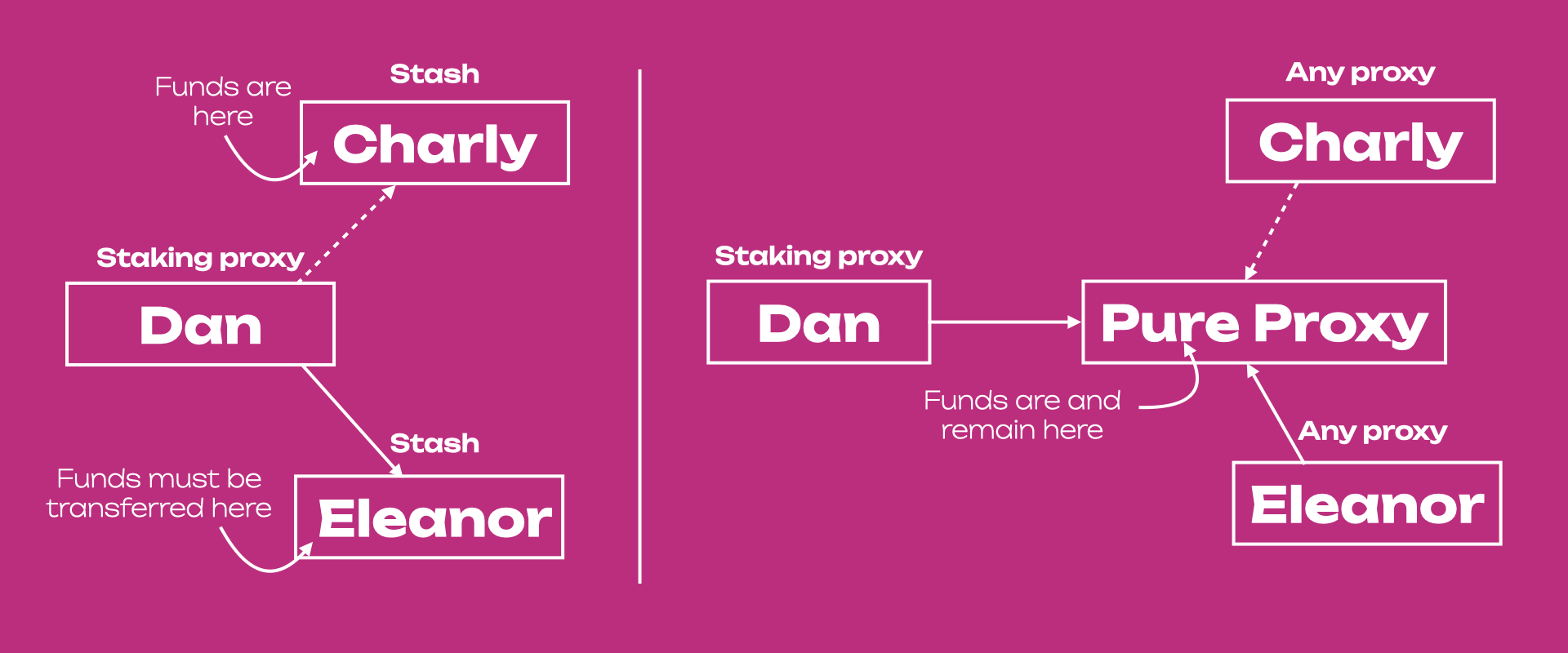
With Pure Proxy (see right side of the Figure above), Charlie must add Eleanor as any proxy of the pure proxy, and remove himself (or Eleanor can remove him). The process requires just 2 signatures (1 signature to add the new any proxy and 1 signature the remove the old one). The funds remain in the pure proxy, and it is not necessary to stop nominating or unbond funds. Also, any proxy relationships with the pure proxy stay in place. Thus, if we use the pure proxy, with an increasing number of proxies we will always have to sign twice (not necessarily true in multi-signature accounts). While if we are not using the pure proxy, the more the proxies the more signatures we need to detach them from the old stash and attach them to the new stash (see Figure below).
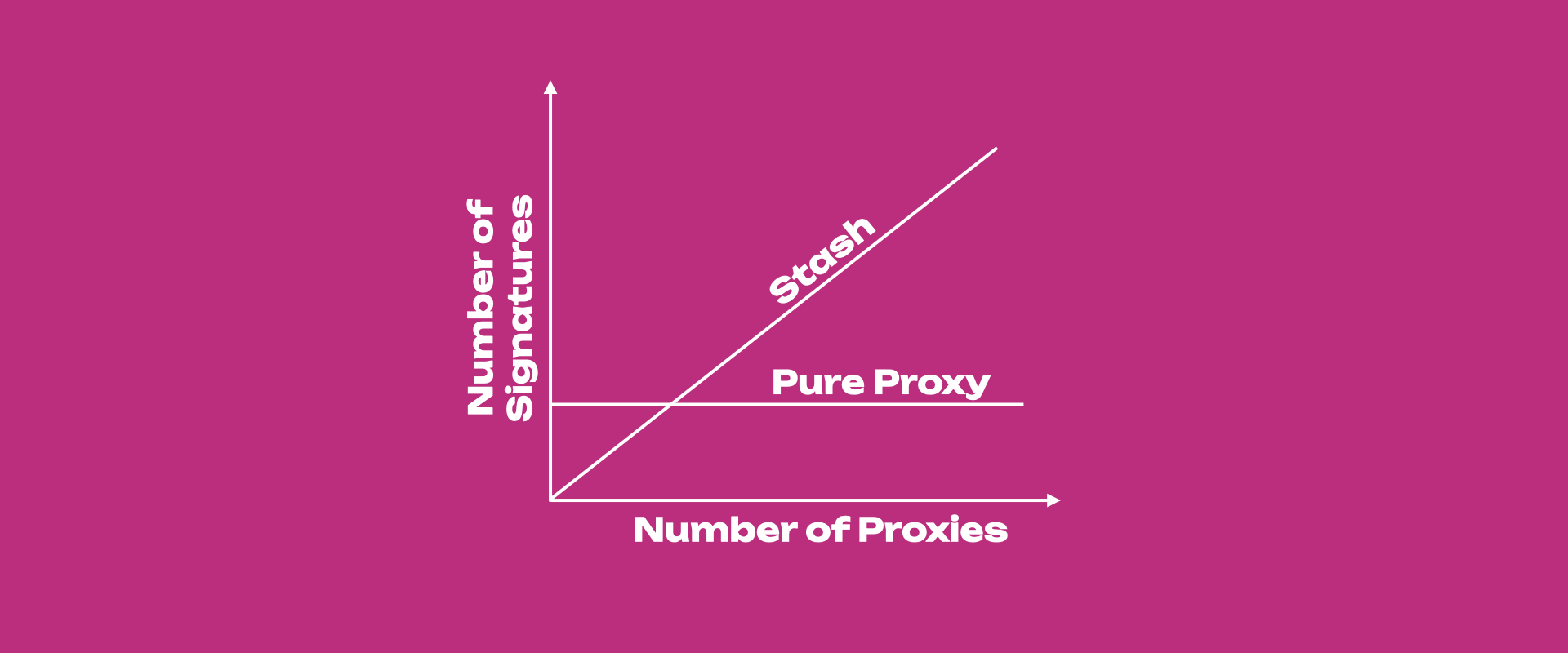
Pure Proxies and Multisigs¶
Scenario One: One Pure Proxy within a Multisig¶
Walk-through tutorial video
You can see this video tutorial that goes through this scenario. The tutorial requires some familiarity with the Extrinsic Tab of the Polkadot-JS UI.
It is possible to put a pure proxy within a multisig, and then transactions will be signed by the
any proxy on behalf of the pure proxy (proxied account). Let's take for example the diagram
below. Alice, Bob and Anon are part of the multisig ABC, a multisig account with threshold 2. P-C is
a pure proxy spawned by Charlie, who now acts as any proxy and thus signs anything on behalf of
P-C. The pure proxy cannot sign directly because it does not have a private key. So, for example,
to send funds from the multisig to Dan, Charly needs to submit a proxy.proxy extrinsic to P-C,
which in turn will submit a multisig.asMulti extrinsic to ABC containing the call data for the
balances.transferKeepAlive extrinsic about the transfer of some funds from ABC to Dan. Alice can
then approve the transfer by submitting a multisig.asMulti extrinsic also containing the call data
for the balances.transferKeepAlive extrinsic about the transfer of some funds from ABC to Dan.
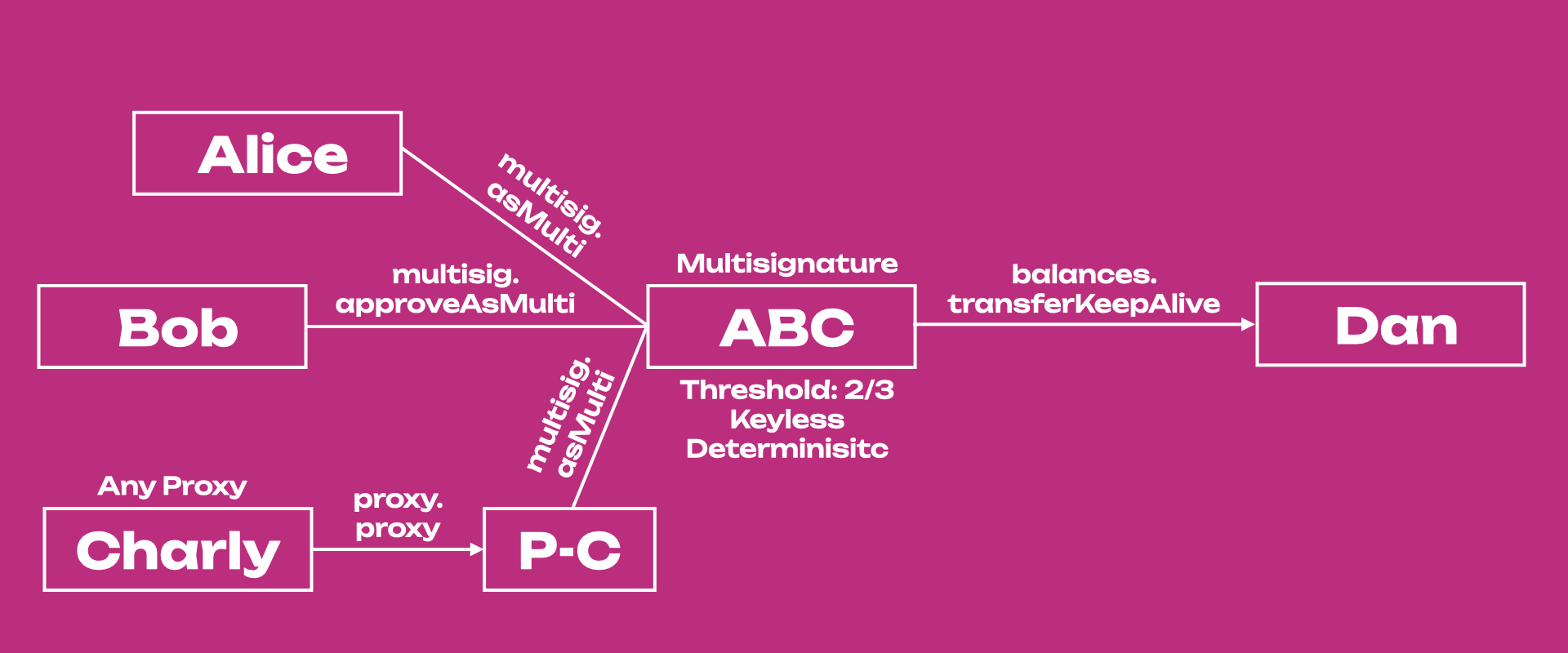
If Charly wants to leave the multisig, a new any proxy can be added to P-C and Charly can be removed (by himself or by the new any proxy). Note that the multisig also contains Bob that in this specific example does not do anything.
Proxy calls
To use a pure proxy within a multisig you need to use the Extrinsic Tab and generate a proxy.proxy extrinsic. If you try to sign a multisig transaction using the pure proxy you will be prompted with a warning. Remember, you cannot sign something directly if you do not have a private key.
Scenario Two: Multisig made of Pure Proxies¶
Walk-through Tutorial Video
You can see this video tutorial that goes through this scenario. The tutorial requires some familiarity with the Extrinsic Tab of the Polkadot-JS UI.
The diagram below shows a multisig that is made only with pure proxies (P-A, P-B and P-C). In this situation Alice, Bob or Charly can leave the multisig at any time without the requirement of creating a new multisig. If for example, Bob leaves the multisig the procedure will require somebody else to be added as any proxy to P-B, and then Bob can remove himself (or the new any proxy can remove Bob).
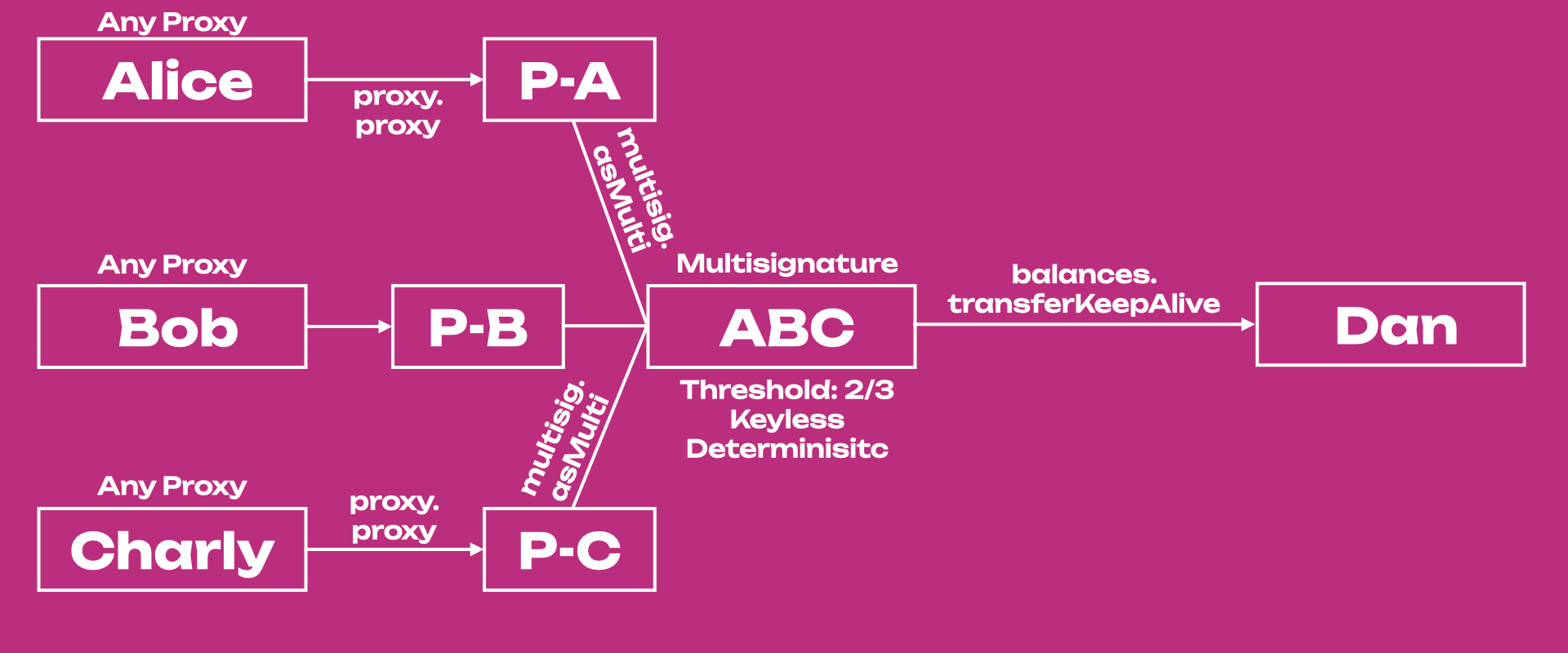
In the diagram above, Alice submits the proxy.proxy extrinsic to P-A, which in turn submits the
multisig.asMulti extrinsic containing the balances.transferKeepAlive extrinsic about the
transfer of some tokens from ABC to Dan. Then, Charly does the same to confirm the transaction. Note
that Charly will need to pay for some weight, for the computation that is necessary to execute the
transaction.
Scenario Three: Multisig controlling a Pure Proxy¶
This setup is used by the MultiX tool.
After its creation, a multi-signature account creates a pure proxy that becomes the proxied account. The multi-signature account behaves as any proxy of the pure. If signatories of the multi-signature account change, a new multisig can be created, assigned as any proxy of the pure, and then the old multisig can be removed as a proxy.
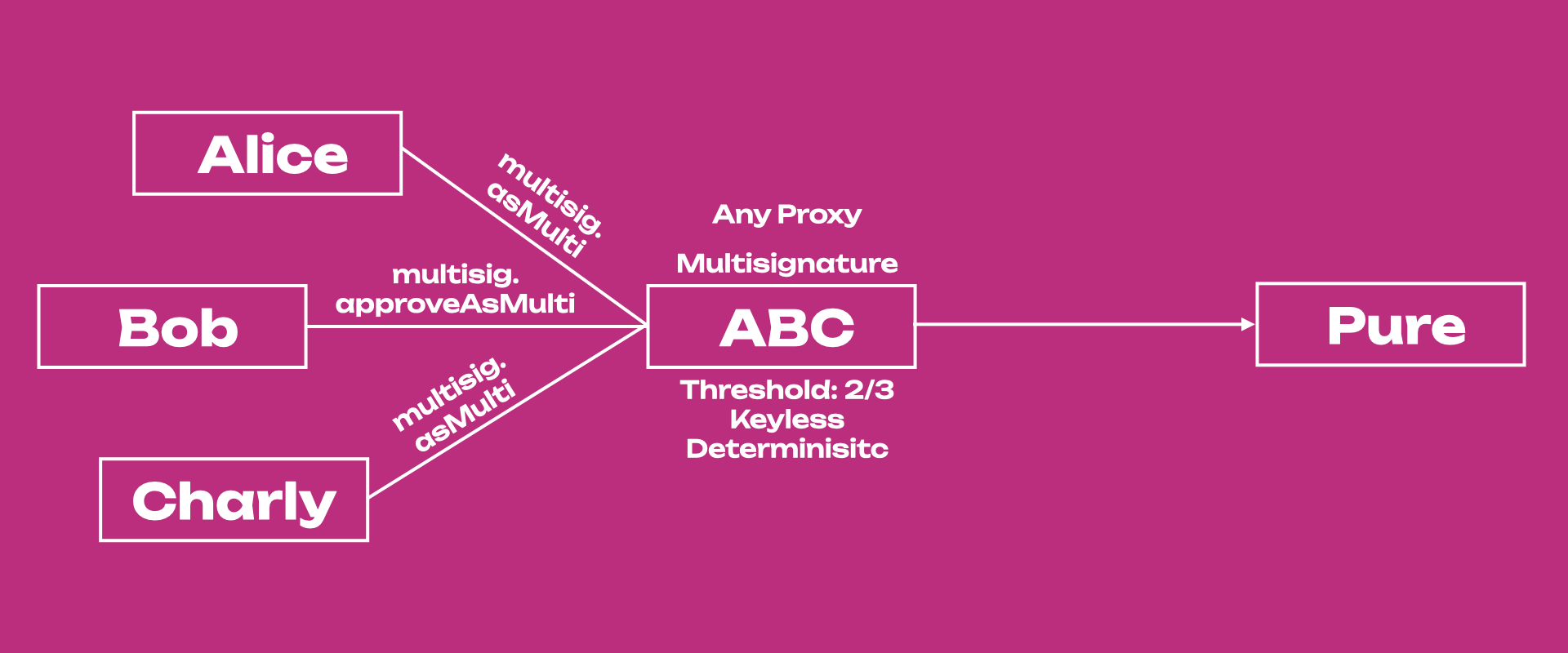
Compared to Scenario Two, signatories do not need to create pure proxies here. Multisig controlling a Pure Proxy is a more practical solution, where the signatories, number of signatories and/or the threshold can be changed, which changes the multisig address but does not impact the pure proxy address. In Scenario Two, if signatories behind the pure proxies change, the address of the multisig stays the same. However, changing the number of signatories and threshold would not be possible.